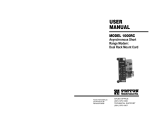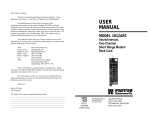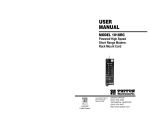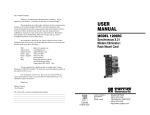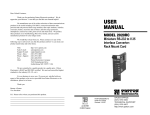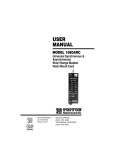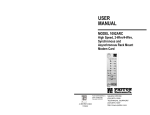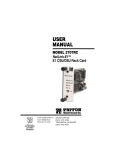Download Patton electronic 1004ABRC Network Card User Manual
Transcript
USER MANUAL MODEL 1004ABRC High Speed, Multipoint Short Range Modem: Rack Mount Card Part# 07M1004ABRC-A SALES OFFICE Doc# 047053UA (301) 975-1000 Revised 09/02/99 CERTIFIED An ISO-9001 Certified Company TECHNICAL SUPPORT (301) 975-1007 http://www.patton.com TABLE OF CONTENTS Section 1.0 WARRANTY INFORMATION Page 1.0 Warranty Information .............................................................2 1.1 Radio and TV Interference 1.2. CE Notice 1.3 Service 2.0 General Information...............................................................4 2.1 Features 2.2 Description 3.0 Configuration..........................................................................5 3.1 Front Card Configuration 3.1.1 Switch Setting - Modem A 3.1.2 Switch Setting - Modem B 3.2 Rear Card Configuration 3.2.1 Rear Card Strap Settings 4.0 Installation ...........................................................................14 4.1 The Model 1000R16 Rack Chassis 4.1.1 The Rack Power Supply 4.2 Installing the Model 1004ABRC into the Chassis 4.3 RS-232 Connection 4.4 Twisted Pair Connection 4.4.1 Point-to Point Twisted Pair Connection 4.4.2 Multipoint Twisted Pair Connection 5.0 Operation .............................................................................19 5.1 LED Status Monitors 5.2 Power-Up Appendix A - Specifications........................................................20 Appendix B - Cable Recommendations......................................21 Appendix C - Factory Replacement Parts ..................................22 Appendix D - Interface Pin Assignments ....................................23 1 Patton Electronics warrants all Model 1004ABRC components to be free from defects, and will—at our option—repair or replace the product should it fail within one year from the first date of shipment. This warranty is limited to defects in workmanship or materials, and does not cover customer damage, abuse or unauthorized modification. If this product fails or does not perform as warranted, your sole recourse shall be repair or replacement as described above. Under no condition shall Patton Electronics be liable for any damages incurred by the use of this product. These damages include, but are not limited to, the following: lost profits, lost savings and incidental or consequential damages arising from the use of or inability to use this product. Patton Electronics specifically disclaims all other warranties, expressed or implied, and the installation or use of this product shall be deemed an acceptance of these terms by the user. 1.1 RADIO AND TV INTERFERENCE The Model 1004ABRC generates and uses radio frequency energy, and if not installed and used properly—that is, in strict accordance with the manufacturer's instructions—may cause interference to radio and television reception. The Model 1004ABRC has been tested and found to comply with the limits for a Class A computing device in accordance with the specifications in Subpart J of Part 15 of FCC rules, which are designed to provide reasonable protection from such interference in a commercial installation. However, there is no guarantee that interference will not occur in a particular installation. If the Model 1004ABRC does cause interference to radio or television reception, which can be determined by turning the power off or disconnecting the RS-232 interface, the user is encouraged to try to correct the interference by one of the following measures: moving the computing equipment away from the receiver, re-orienting the receiving antenna and/or plugging the receiving equipment into a different AC outlet (such that the computing equipment and receiver are on different branches). In the event the user detects intermittent or continuous product malfunction due to nearby high power transmitting radio frequency equipment, the user is strongly advised to take the following steps: use only data cables with an external outer shield bonded to a metal or metalized connector; and, configure the rear card as shown in section 3.2.1 of this manual. 2 2.0 GENERAL INFORMATION 1.2 CE NOTICE The CE symbol on your Patton Electronics equipment indicates that it is in compliance with the Electromagnetic Compatibility (EMC) directive and the Low Voltage Directive (LVD) of the Union European (EU). A Certificate of Compliance is available by contacting Technical Support. 1.3 SERVICE All warranty and non-warranty repairs must be returned freight prepaid and insured to Patton Electronics. All returns must have a Return Materials Authorization number on the outside of the shipping container. This number may be obtained from Patton Electronics Technical Support: Tel: (301) 975-1007 Email: [email protected]. www: http://www.patton.com NOTE: Packages received without an RMA number will not be Thank you for your purchase of this Patton Electronics product. This product has been thoroughly inspected and tested and is warranted for One Year parts and labor. If any questions during installation or use of the 1004ABRC, contact Patton Electronics Technical Support at (301) 975-1007. 2.1 FEATURES • Convenient rack card features two short range modems • Data rates to 115.2 Kbps • Multi-point Operation on Data Transitions -- No need for Hardware Control Signals • Supports up to 50 multipoint drops in a polling environment • Passes transmit & receive data • Variable high/low impedance settings • Operates with or without local “echo” • Features 6 easy-to-read LEDs • Silicon Avalanche Diode surge protection • Fits conveniently in Patton’s rack chassis accepted. 2.2 DESCRIPTION Patton Electronics' technical staff is also available to answer any questions that might arise concerning the installation or use of your Model 1004ABRC. Technical Service hours: 8AM to 5PM EST, Monday through Friday. The Model 1004ABRC high speed, multipoint short range modem rack card is a dual rack card incorporating two short range modems. Both units support asynchronous data rates to 115.2 Kbps over 1 or 2 twisted pairs and support distances to 4000 feet (19 AWG @19.2 kbps). In addition, Model 1004ABRC’s unique data control feature allows it to be used in multi-point environments without the use of hardware control signals. The Model 1004ABRC can handle up to 50 terminal drops in a multipoint polling environment. Using transitions on the data line to handle line contention, the Model 1004ABRC can be used in environments that need multi-port bus contention, but do not have control signals such as RTS or DTR. The Model 1004ABRC may be configured for high or low impedance operation, and the unit can operate with or without “echo”. Filling one function card slot on Patton’s Model 1000R16 rack chassis, the Model 1004ABRC is available with RJ-11 or RJ-45 rear interface cards. For workgroup and desktop communications, the Model 1004ABRC also fits in Patton’s 2, 4 and 8 slot ClusterBoxes™. The combination of rack mount, ClusterBox™ and self-powered units provides a completely integrated “networking” solution. 3 4 3.0 CONFIGURATION 3.1.1 SWITCH SETTINGS - MODEM “A” This section describes the location and orientation of the Model 1004ABRC's configuration switches, provides detailed instructions on setting each switch and describes the settings for each of the rear connection cards. DIP switches S1 and S2 configure short range Modem A on the Model 1004ABRC front card. The tables below provide an overview of Modem A switch settings, including factory default settings. Following the tables is a descriptions of each switch’s function. 3.1 FRONT CARD CONFIGURATION SWITCH SET “S1” The Model 1004ABRC front card houses two short hauls–Modem A and Modem B– each using two sets of DIP switches. The locations of these switches are shown in Figure 1 (below). These switches are accessible when the card is slid out of the rack chassis. Once configured, the Model 1004ABRC is designed to operate transparently, without need for frequent re-configuration. DIP switch S1 is used to configure receive impedance, RTS/CTS delay, carrier control operation and “echo” enable/disable. The summary table below shows the factory default settings for switch S1. Following the summary table is a detailed description of each individual switch. SWITCH S1 SUMMARY TABLE (factory defaults in bold) S2 S1 S4 S3 Figure 1. Model 1004ABRC Card, showing location of configuration switches. Each of the DIP switches on the Model 1004ABRC function card is a 4-position switch. Figure 2 (below) shows the On/Off orientation of these switches. Use a small screw driver or similar instrument to set each individual switch. Position Function ON Position OFF Position S1-1 RX Impedance 120 Ohm 16K Ohm S1-2 RTS/CTS Delay 8 msec No Delay S1-3 Reserved - Default Setting S1-4 Echo Mode Echo ON Echo OFF S1-1: Receive Impedance The setting for switch S1-1 selects the impedance of the input receiver. You may select either a “low” impedance of 120 Ohms or a “high” impedance of 16K Ohms. By selecting the proper impedance for each drop, there may be up to 50 receivers in one application. S1-1 On Off Setting Low (120 Ohm) High (16K Ohm typical) S1-2: RTS/CTS Delay ON OFF ON 1 The setting for switch S1-2 determines the amount of delay between the time the Model 1004ABRC “sees” RTS and when it turns on CTS. Note: RTS/CTS Delay setting should be based upon transmission timing. 2 3 4 S1-2 On Off Setting 8 msec no delay Figure 2. Close-up of DIP switches, showing ON/OFF orientation. 5 6 S1-3: Reserved S2-1 and S2-2: “Transmit Off” Impedance Switch S1-3 is reserved and must remain in the OFF position. Setting Not a Valid Setting Default Setting S1-3 On Off S2-1 On Off S1-4: Echo Mode The setting for switch S1-4 determines whether the Model 1004ABRC echoes data back to the transmitting device (half-duplex mode only). S1-4 On Off Switches S2-1 and S2-2 are set together to determine whether the receiving device “sees” the impedance of the Model 1004ABRC’s transmitter as being “high” or “intermediate” when the transmitter is turned off. The “intermediate” setting is useful in half-duplex environments where the receiving device does not respond well to the “high” setting. S2-2 On Off Setting Intermediate Impedance High Impedance S2-3 and S2-4: 2-wire/4-wire Modes Switches S2-3 and S2-4 are set together to determine whether the Model 1004ABRC is in 2-wire or 4-wire operating mode. Note: 2-wire mode is half-duplex only. Setting Echo On Echo Off S1-2 On Off SWITCH SET “S2” DIP switch S2 is used to configure transmit impedance, and 2-wire/4-wire operations. The summary table below shows the factory default settings for switch S2. Following the summary table is a detailed description of each individual switch. SWITCH S2 SUMMARY TABLE (factory defaults in bold) Position Function ON Position OFF Position S2-1* TX Impedance Intermediate High S2-2* TX Impedance Intermediate High S2-3* 2-Wire/4-Wire 2-Wire 4-Wire 2-Wire/4-Wire 2-Wire 4-Wire S2-4* *Note: Switches S2-1 and S2-2 must be switched simultaneously. Switches S2-3 and S2-4 must be switched simultaneously. 7 S1-3 On Off Setting 2-wire mode 4-wire mode 3.1.2 SWITCH SETTINGS - MODEM “B” DIP switches S3 and S4 configure short range Modem B on the Model 1004ABRC front card. The tables below provide an overview of Modem A switch settings, including factory default settings. Following each figure is a detailed description of each switch’s function. SWITCH SET “S3” DIP switch S3 is used to configure receive impedance, RTS/CTS delay and “echo” enable/disable. The summary table below shows the factory default settings for switch S3. Following the summary table is a detailed description of each individual switch. SWITCH S3 SUMMARY TABLE (factory defaults in bold) Position Function ON Position OFF Position S3-1 RX Impedance 120 Ohm 16K Ohm S3-2 RTS/CTS Delay 8 msec No Delay S3-3 Reserved - Default Setting S3-4 Echo Mode Echo ON Echo OFF 8 S3-1: Receive Impedance SWITCH SET “S4” The setting for switch S3-1 selects the impedance of the input receiver. You may select either a “low” impedance of 120 Ohms or a “high” impedance of 16K Ohms. By selecting the proper impedance for each drop, there may be up to 50 receivers in one application. DIP switch S4 is used to configure transmit impedance, and 2-wire/4-wire operations. The summary table below shows the factory default settings for switch S4. Following the summary table is a detailed description of each individual switch. S3-1 On Off Setting Low (120 Ohm) High (16K Ohm typical) SWITCH S4 SUMMARY TABLE (factory defaults in bold) Position Function ON Position OFF Position S4-1* TX Impedance Intermediate High S3-2: RTS/CTS Delay S4-2* TX Impedance Intermediate High The setting for switch S3-2 determines the amount of delay between the time the Model 1004ABRC “sees” RTS and when it turns on CTS. Note: RTS/CTS Delay setting should be based upon transmission timing. S4-3* 2-Wire/4-Wire 2-Wire 4-Wire S3-2 On Off Setting 8 msec no delay Switches S4-3 and S4-4 must be switched simultaneously. S4-1 and S4-2: “Transmit Off” Impedance S3-3: Reserved Switch S3-3 is reserved and must remain in the OFF position. S3-3 On Off 2-Wire/4-Wire 2-Wire 4-Wire S4-4* *Note: Switches S4-1 and S4-2 must be switched simultaneously. Setting Not a Valid Setting Default Setting Switches S4-1 and S4-2 are set together to determine whether the receiving device “sees” the impedance of the Model 1004ABRC’s transmitter as being “high” or “intermediate” when the transmitter is turned off. The “intermediate” setting is useful in half-duplex environments where the receiving device does not respond well to the “high” setting. S4-1 On Off S4-2 On Off Setting Intermediate Impedance High Impedance S3-4: Echo Mode The setting for switch S3-4 determines whether the Model 1004ABRC echoes data back to the transmitting device (half-duplex mode only). S3-4 On Off Setting Echo On Echo Off S4-3 and S4-4: 2-wire/4-wire Modes Switches S4-3 and S4-4 are set together to determine whether the Model 1004ABRC is in 2-wire or 4-wire operating mode. Note: 2-wire mode is half-duplex only. S4-2 On Off 9 S4-3 On Off Setting 2-wire mode 4-wire mode 10 3.2 REAR CARD CONFIGURATION The Model 1004ABRC has two interface card options: the 1Q11 (which comes equipped with two RJ-11 ports and two RJ-45 ports) and the 1Q45 (which comes equipped with four RJ-45 ports). Figure 3 (below) illustrates these two different rear interface options. 1Q11 RS-232 Connection } } Twisted Pair Line Connection 1Q45 RJ-11 RJ-45 RJ-11 RJ-45 RJ-45 RJ-45 RJ-45 RJ-45 } } Twisted Pair Line Connection RS-232 Connection The table below provides a summary of the strap functions for both of the rear cards. Following the table is a description of each strap's function. INTERFACE CARD STRAP SUMMARY TABLE #1 Strap Position 1&2 Position 2&3 JB2 Line A Shield No Shield† JB4 Line B Shield No Shield† JB5 SGND & FRGND Open† JB6 DTE A DSR† N/A JB7 DTE B DSR N/A † Line A Shield & Line B Shield (JB2 & JB4) This strap pertains to the line interface. In the connected (closed) position, the strap links RJ-11 pins 1 and 6 (RJ-45 pins 2 and 7) to frame ground. These pins can be used as connections for the twisted pair cable shield. In the open (disconnected) position, pins 1 and 6 (or 2 and 7) remain connected, but are “lifted” from frame ground. Figure 3. Model 1004ABRC interface card options Prior to installation, you should examine the rear card you have selected and ensure that it is suitable for your application. Each rear card is configured by setting straps on the PC board. Section 3.4.1 describes the strap locations and settings for each card. 3.2.1 REAR CARD STRAP SETTINGS Figure 4 (below) shows the strap locations for the 1Q11 and the 1Q45 rear cards. These straps determine various grounding characteristics for the RS-232 and twisted pair lines. JB2 Position 1&2 = Line A Shield Connected Position 2&3 = No Shield JB4 Position 1&2 = Line B Shield Connected Position 2&3 = No Shield SGND & FRGND (JB5) JB2 1 2 3 (Unit A) (Unit B) JB4 1 2 3 JB5 (Unit A) 1 2 3 (Unit B) } } Twisted Pair Line Connection RS-232 Connection In the connected (closed) position, this strap links signal ground and frame ground. In the open (disconnected) position, pin 1 is “lifted” from frame ground. JB5 Position 1&2 = SGND and FRGND Connected Position 2&3 = SGND and FRGND Not Connected JB6 JB7 1 2 3 1 2 3 Figure 4. Strap locations for both rear cards 11 12 4.0 INSTALLATION DTE as DSR or RI (JB6 & JB7) Because this rear card is designed to function in more applications than the Model 1004ABRC, this jumper must be installed only in one position. Place the jumper across pins 1&2 so that the terminal (DTE) sees DSR as high when the DTE raises DTR. The other positions, across pins 2&3, are for Ring Indicate as defined by EIA/TIA-561. The RI function is irrelevant (and on the Model 1004ABRC is also disconnected) and can cause improper operation if the jumper is installed incorrectly. JB6 & JB7 Position 1&2 = DSR Position 2&3 = N/A This section describes the functions of the Model 1000R16 rack chassis, tells how to install front and rear Model 1004ABRC cards into the chassis and provides diagrams for wiring up the interface connections correctly. 4.1 THE MODEL 1000R16 RACK CHASSIS The Model 1000R16 Rack Chassis (Figure 5) has sixteen short range modem card slots, plus its own power supply. Measuring only 3.5” high, the Model 1000R16 is designed to occupy only 2U in a 19” rack. Sturdy front handles allow the Model 1000R16 to be extracted and transported conveniently. Figure 5. Model 1000R16 Rack Chassis with power supply 4.1.1 THE RACK POWER SUPPLY The power supply included in the Model 1000R16 rack uses the same mid-plane architecture as the modem cards. The front card of the power supply slides in from the front, and the rear card slides in from the rear. They plug into one another in the middle of the rack. The front card is then secured by thumb screws and the rear card by conventional metal screws. WARNING! There are no user-serviceable parts in the power supply section of the Model 1000R16. Voltage setting changes and fuse replacement should only be performed by qualified service personnel. Contact Patton Electronics Technical support at (301)975-1007 for more information. 13 14 Switching the Power Supply On and Off The power switch is located on the front panel. When plugged in and switched on, a red front panel LED will glow. Since the Model 1000R16 is a “hot swappable” rack, it is not necessary for any cards to be installed before switching on the power supply. The power supply may be switched off at any time without harming the installed cards. NOTE: Please refer to the Model 1000RP Series User Manual AC and DC Rack Mount Power Supplies for fuse and power card replacement information. 4.2 INSTALLING THE MODEL 1004ABRC INTO THE CHASSIS The Model 1004ABRC is comprised of a front card and a rear card. The two cards meet inside the rack chassis and plug into each other by way of mating 50 pin card edge connectors. Use the following steps as a guideline for installing each Model 1004ABRC into the Model 1000R16 rack chassis: 1. Slide the rear card into the back of the chassis along the metal rails. 2. Secure the rear card using the metal screws provided. 3. Slide the front card into the front of the chassis. It should meet the rear card when it's almost all the way into the chassis. 4. Push the front card gently into the card-edge receptacle of the rear card. It should “click” into place. 5. Secure the front card using the thumb screws. The Model 1004ABRC is wired as a DCE (Data Communications Equipment). Therefore, it wants to connect to a DTE (Data Termination Equipment). If your RS-232 output device is a DTE, you may need to use a special cable (such as a DB-25 to modular cable). If your RS-232 output device is DCE, you will require a null modem connection. Call Patton Technical Support at (301) 975-1007 for specific installation instructions. 4.4 TWISTED PAIR CONNECTION The Model 1004ABRC operates half or full duplex over one or two twisted pair. In all applications, the twisted pair wire must be 26 AWG or thicker, unconditioned, dry, metallic wire. Both shielded and unshielded wire yield favorable results. NOTE: The Model 1004ABRC can only communicate in a closed data circuit with another Model 1004ABRC. Dial-up analog circuits, like those in a standard Hayes-type modem, are not acceptable. For further information, see Appendix B. 4.4.1 POINT-TO-POINT TWISTED PAIR CONNECTION The 6-position RJ-11 and 8-position RJ-45 jack options for the Model 1004ABRC (always the upper jack on the rear interface card) are prewired for a standard TELCO wiring environment. Connection of a 2-wire or 4-wire twisted pair circuit between two or more Model 1004ABRCs requires a crossover cable as shown in the following charts. RJ-11 RJ-45 1 ...................GND† 2 ...................RCV3 ...................XMT+ 4 ...................XMT5 ...................RCV+ 6 ...................GND NOTE: Since the Model 1000R16 chassis allows “hot swapping” of cards, it is not necessary to power down the rack when you install or remove a Model 1004ABRC. 4.3 RS-232 CONNECTION The RS-232 ports are always the lower ports on the interface card. The 10-pin RJ-45 is pinned according Patton's Modified Modular Interface Standard (based on the EIA/TIA-561Standard). For specific interface pin-outs, please refer to the diagrams in Appendix D. SIGNAL 1 ...................N/C 2 ...................GND 3 ...................RCV4 ...................XMT+ 5 ...................XMT6 ...................RCV+ 7 ...................GND 8 ...................N/C Connection to ground is optional † 1 2 3 4 5 6 7 8 1 2 3 4 5 6 (continued) 15 SIGNAL 16 When connecting two Model 1004ABRCs, it is necessary to use a crossover cable. The diagrams below show how a crossover cable should be constructed for the following environments: 4-wire RJ-11, 4-wire RJ-45, 2-wire RJ-11 or 2-wire RJ-45. RJ-11 Cable (4-Wire) SIGNAL PIN# PIN# GND† RCVXMT+ XMTRCV+ GND† 1-----------------------6 2-----------------------4 3-----------------------5 4-----------------------2 5-----------------------3 6-----------------------1 SIGNAL GND† XMTRCV+ RCVXMT+ GND† Connection to ground is optional † 4.4.2 MULTIPOINT TWISTED PAIR CONNECTION The Model 1004ABRC supports multipoint applications using a star daisy chain topology (Section 3.0 describes proper multipoint configuration). Maximum distance between the units will vary based upon the number of drops, data rate, wire gauge, etc. Call Patton Technical Support for specific distance estimates. The diagram below shows how to wire the two-pair cables properly for a Model 1004ABRC star topology. Note that the ground connection is not needed. HOST XMT+ FIRST SLAVE SECOND SLAVE RCV+ RCV+ XMT- RCVRCV- RJ-45 Cable (4-Wire) SIGNAL PIN# PIN# GND† RCVXMT+ XMTRCV+ GND† 2-----------------------7 3-----------------------5 4-----------------------6 5-----------------------3 6-----------------------4 7-----------------------2 RCV+ XMT+ XMT+ SIGNAL GND† XMTRCV+ RCVXMT+ GND† RCV- XMTXMT- RJ-11 Cable (2-Wire) SIGNAL PIN# PIN# XMT+ XMT- 3-----------------------3 4-----------------------4 SIGNAL XMT+ XMT- RJ-45 Cable (2-Wire) SIGNAL PIN# PIN# XMT+ XMT- 4-----------------------4 5-----------------------5 SIGNAL XMT+ XMT- Connection to ground is optional † 17 18 5.0 OPERATION APPENDIX A Once you have configured each Model 1004ABRC and connected the cables, you are ready to operate the units. Section 5.0 describes the LED status monitors and the power-up procedure. 5.1 LED STATUS MONITORS The Model 1004ABRC features front panel LEDs that indicate the condition of the modem and communication link. Figure 6 (below) shows the positions of the LEDs. PATTON ELECTRONICS MODEL 1004ABRC SPECIFICATIONS Transmission Format: Asynchronous Data Rate: 0 to 115.2 Kbps Surge Protection: Silicon Avalanche Diodes Control Signals: DSR turns “ON” immediately after the terminal raises DTR; DCD turns “ON” after recognizing the receive signal from the line; CTS turns on after the terminal raises RTS Transmission Line: 2-wire or 4-wire, unconditioned twisted pair Transmit Mode: Full or half duplex Model 1004RC Power TD Unit A RD CD Transmit Level: 2V ± 10% differential output voltage TD Unit B RD CD Carrier: RTS/CTS Delay: Controlled by data transitions 8 msec or zero Echo Mode: Echo and No Echo, supported in both 2-wire and 4-wire modes Receiver Impedance: Low (120 ohms), High (100k Ohms) Line Connection: RJ-11 or RJ-45 jack Surge Protection: Silicon Avalanche Diodes on twisted pair interface from each line to frame ground Power Supply: Rack-mount power supply is switchable between 120V and 240V AC; rack chassis supplies 10V AC to the Model 1004ABRC, typical consumption is 700 mW per card Fuse: 400mA for 120V applications; 200mA for 240V applications Temperature Range: 0-50°C (32-122°F) Altitude: 0-15,000 feet Humidity: Up to 95% non-condensing Dimensions: 0.95”w x 3.1”h x 5.4”l Figure 6. The Model 1004ARC front panel, showing LED positions • The green “PWR” LED glows when power is applied to the modem through its mid-plane chassis connection. • The green “TD” and “RD” LEDs show positive state data activity. The red “TD” and “RD” LEDs show negative state data activity. A solid red light indicates an idle state. • The green “CD” LED lights when the receive carrier is detected; the red LED lights when the receive carrier is absent. 5.2 POWER-UP There is no power switch on the Model 1004ABRC: Power is automatically applied to the 1004ABRC when its card-edge connector touches the chassis’ mid-plane socket, or when the chassis’ power is turned on. NOTE: The 1004ABRC is a “hot swappable” card—it will not be damaged by plugging it in or removing it while the rack is powered up. 19 20 APPENDIX B APPENDIX C PATTON ELECTRONICS MODEL 1004ABRC CABLE RECOMMENDATIONS PATTON ELECTRONICS MODEL 1004ABRC FACTORY REPLACEMENT PARTS The Patton Model 1004ABRC operates at frequencies of 115kHz or less and has been performance tested by Patton technicians using twisted-pair cable with the following characteristics: The Patton Model 1004ABRC rack system features interchangeable rear half cards, power cords/fuses for international various operating environments and other user-replaceable parts. Model numbers and descriptions for these parts are listed below: Wire Gauge Capacitance Resistance 19 AWG 22 AWG 24 AWG 83nf/mi or 15.72 pf/ft. 83nf/mi or 15.72 pf/ft. 83nf/mi or 15.72 pf/ft. .0163 Ohms/ft. .0326 Ohms/ft. .05165 Ohms/ft. Patton Model # To gain optimum performance from the Model 1004ABRC, please keep the following guidelines in mind: • Always use twisted pair wire—this is not an option. Description 1000RPEM..........................120/240V Rear Power Entry Module 1000RPSM-2.......................120/240V Front Power Supply Module 1000RPEM-DC ...................DC Rear Power Entry Module 1000RPSM-48A ..................48V Front Power Supply Module 1000RPEM-V ......................120/240V CE Compliant Rear Power Entry Module 1000RPEM-V ......................120/240V CE Compliant Rear Power Supply Entry Module • Use twisted pair wire with a capacitance of 20pf/ft or less. • Avoid twisted pair wire thinner than 26 AWG (i.e. avoid higher AWG numbers than 26) • Use of twisted pair with a resistance greater than the above specifications may cause a reduction in maximum distance obtainable. Functionality should not be affected. • Many environmental factors can affect the maximum distances obtainable at a particular site. Use the above data rate/distance table as a general guideline only. 0805US ...............................American Power Cord 0805EUR.............................European Power Cord CEE 7 0805UK ...............................United Kingdom Power Cord 0805AUS .............................Australia/New Zealand Power Cord 0805DEN.............................Denmark Power Cord 0805FR ...............................France/Belgium Power Cord 0805IN.................................India Power Cord 0805IS.................................Israel Power Cord 0805JAP..............................Japan Power Cord 0805SW ..............................Switzerland Power Cord 0516FPB1 ...........................Single Width Blank Front Panel 0516FPB4 ...........................4-Wide Blank Front Panel 0516RPB1...........................Single Width Blank Rear Panel 0516RPB4...........................4-Wide Blank Rear Panel 21 22 APPENDIX D PATTON ELECTRONICS MODEL 1004ABRC INTERFACE PIN ASSIGNMENTS PATTON MODULAR INTERFACE - 10 Wire RJ-45 Contact Number Circuit 1 N/A Not Used Description 2 125 DSR 3 109 Received Line Signal Indicator (CD) 4 108 / 2 5 102 Signal Common 6 104 Received Data 7 103 Transmitted Data 8 106 Clear to Send 9 105 / 133 10 N/A DTE Ready (DTR) Request to Send / Ready for Receiving Not Used Pins 2-9 conform to the EIA/TIA-561 eight position non-synchronous interface standard. Copyright © 1999 Patton Electronics Company All Rights Reserved 23













